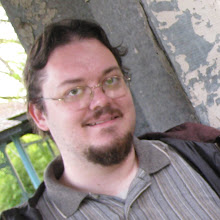This post will require some thought to ferret out its intended meanings, which are esoteric. As a reminder, this article is copyrighted by myself and may not be reprinted without permission. You might take this article as sort of a guided meditation, where you could re-enact in your mind the acts of ministry which are discussed.
The Work of the Priesthood in the Tabernacle and Temple
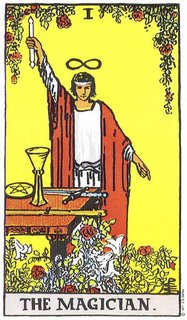 The Magician in the Tarot deck (Don't leave yet! I promise, the introduction here is my only Tarot reference.) holds in his hand a wand. A wand is another manifestation of the rod, or the staff. On the table before him lay a chalice, a coin (sometimes called pentacles, although this is a later innovation), a sword, and a wand. We will begin by equating the rod to fire, and the chalice to water. The sword is active, and will represent air. The coin is passive, and will represent earth. The magician is using the rod calling down divine energy from above, and channeling it to the earth (indicated by his finger pointing down at the earth). Moses is said to have used this same power:
The Magician in the Tarot deck (Don't leave yet! I promise, the introduction here is my only Tarot reference.) holds in his hand a wand. A wand is another manifestation of the rod, or the staff. On the table before him lay a chalice, a coin (sometimes called pentacles, although this is a later innovation), a sword, and a wand. We will begin by equating the rod to fire, and the chalice to water. The sword is active, and will represent air. The coin is passive, and will represent earth. The magician is using the rod calling down divine energy from above, and channeling it to the earth (indicated by his finger pointing down at the earth). Moses is said to have used this same power:
And Moses stretched forth his rod toward heaven: and the LORD sent thunder and hail, and the fire ran along upon the ground; and the LORD rained hail upon the land of Egypt. (Exodus 9:23)
FIRE (Active Element #1)At the dedication of the Tabernacle, and likewise at Solomon's Temple the priests called fire down out of heaven.
Now when Solomon had made an end of praying, the fire came down from heaven, and consumed the burnt offering and the sacrifices; and the glory of the LORD filled the house. (2 Chronicles 7:1)
This fire burnt upon the altar of sacrifice in the
courtyard. This sacred or divine fire was the only fire authorized to be used in the services of the Temple. It can be taken symbolically as a re-enactment of God's proclamation:
"Let there be light."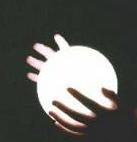
This original light which God created was clearly different from ordinary fire, because God did not separate the light from the darkness, nor did he create the sun and the moon until later in the narrative.
A few Bible quotations for contemplation:
And Elijah answered and said to the captain of fifty, If I be a man of God, then let fire come down from heaven, and consume thee and thy fifty. And there came down fire from heaven, and consumed him and his fifty. (2 Kings 1:10)
David also called upon heavenly fire:
And David built there an altar unto the LORD, and offered burnt offerings and peace offerings, and called upon the LORD; and he answered him from heaven by fire upon the altar of burnt offering. (1 Chronicles 21:26)
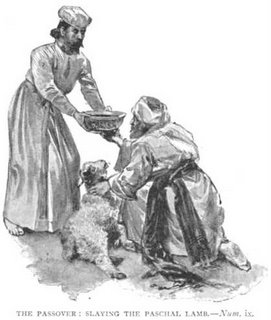
This divine fire, in the context of the Temple, demonstrates God's blessing upon the work in which the Israelites were engaged, and by it they were able to perform the rest of their ministry.
The altar upon which the fire burned was used for sacrifices which were brought to the tabernacle (or Temple). If a common person sinned, they were instructed to bring a female kid of the goats or a female lamb which they (not the priest) were required to sacrifice upon a table. The individual bringing the offering would slit the throat of the animal, the same way Kosher slaughtering occurs to this day, and the priest would provide a vessel in which to catch the blood of the sacrifice. After this, the priest would put the animal upon the altar, and the blood upon the four horns of the altar and pour the remainder out at the base of the altar (Leviticus 4:27-35) . The priests which performed this service were the Sons of Aaron, the Kohanim, or the Cohens, as they are known today. The priests wore white vestments, with a blue ribband at the edge of their garments, as described in the Bible. This clothing is a worthwhile study in its own right, but I will only go so far as to mention it here.
AIR (Active Element #2)Exodus chapter 30 verse 7 through 9 tells us that Aaron was commanded morning and evening to burn incense upon the altar in the Holy Place, or
Middle Chamber of the tabernacle. We know that this duty was assigned to the ordinary priests as well, for it was the duty that Zacharias, the father of John the Baptist, had been selected for on the day that the angel appeared to him to inform him of John's upcoming birth and to instruct him as to what name should be given to the child.
And it came to pass, that while he [Zacharias] executed the priest's office before God in the order of his course, According to the custom of the priest's office, his lot was to burn incense when he went into the temple of the Lord. And the whole multitude of the people were praying without at the time of incense. (Luke 1:8-10)
It was the most distinguished and honorable duty that the ordinary priests could perform; the pinnacle of their service in the Temple. The Priests were to minister in the Courtyard and in the Holy [Place], but only the High Priest could minister in the entire Temple, including the Holy of Holies, the Most Holy, or Sanctum Sanctorum, as it is called.
The Bible informs us of the requirements for entering to serve in the Holy (Kadosh):
Who shall ascend into the hill of the LORD? or who shall stand in his holy place? He that hath clean hands, and a pure heart; who hath not lifted up his soul unto vanity, nor sworn deceitfully. (Psalm 24:3-4)
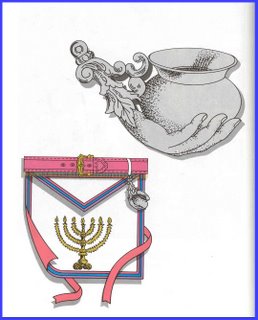
This passage is symbolic. While the priests were required to wash in the laver before entering the Holy Place, the right hand was also customarily known as the clean hand, and anything brought into the ministry before God would have been carried in the right hand, such as was the case with the incense. Worshipful Bro. H. Meij has written
a wonderful article on the pot of incense and why it is symbolically associated with a "pure heart," and I will not take the time to repeat his material here. The priest had to be humble (not puffed up in vanity) and, and not sworn deceitfully. In other word, he must have kept his priestly covenants, obligations, or vows; or, to have shown suitable proficiency in his preceeding ministry to entitle him to enter. The priest was required to burn the incense on fire taken from the sacred fire at the altar of burnt offering in the courtyard. (And Nadab and Abihu died, when they offered strange
fire before the L
ORD. ~Numbers 26:61) So the priest, using the fire from heaven, entered the Holy Place carrying incense in his right hand - his clean hand, and he would pour it out of his hand over the altar of incense, while "the whole multitude of the people were praying without."
If any of the priests sinned, they would sprinkle the blood of their offering seven times before the vail (the entrance to the Holy of Holies) and put blood upon the horns of the incense altar in the Holy Place, pouring the remainder out at the base of the altar of sacrifice in the courtyard.
Incense is often connected with prayer:
Let my prayer be set forth before thee as incense; and the lifting up of my hands as the evening sacrifice. (Psalm 141:2)
And another angel came and stood at the altar, having a golden censer; and there was given unto him much incense, that he should offer it with the prayers of all saints upon the golden altar which was before the throne. And the smoke of the incense, which came with the prayers of the saints, ascended up before God out of the angel’s hand. (Revelation 8:3-4)
WATER (Passive Element #1)The High Priest, in addition to his various daily duties, had the special privilege and responsibility of officiating during Yom Kippur (Day of Atonement) services, the yearly cleansing ceremony which ultimately atoned for the previously confessed sins of the people for the entire preceeding year. On this special day the priest was allowed to enter the Sanctum Sanctorum, or
Holy of Holies. The High Priest in his standard ministry wore robes that were more ornamental than those of the other priests, but on the Day of Atonement, he stripped off his colorful vestments, and wore only the white robes, very similar to the robes which the other priests wore during their services.
In the context of Temple-centered Judaism, there was typically only one High Priest at a time (I have seen a chart showing that exceptions to this arrangement have been made, however.)
This arrangement is similar to the ancient Masonic arrangement of having a Lodge of Fellowcrafts presided over by a Master. Over the course of time, within Masonry, we have changed our custom so that we now have lodges consisting entirely of Masters, with one of them deemed "Worshipful," and the Master's degree is now given to all worthy brethren instead of only those becoming the Master of a Lodge.
On Yom Kippur, the High Priest would offer a bullock as a sacrifice:
And Aaron shall offer his bullock of the sin offering, which is for himself, and make an atonement for himself, and for his house. (Leviticus 16:6)
Masonic tradition informs us, concerning Hiram Abif, that
"it was the usual custom of this great and good man, at high twelve, when the Craft was called from labor to refreshment, to enter the Sanctum Sanctorum, or Holy of Holies, there to order up his adorations to Deity and draw his designs on the Trestle-board." This text is according to a Mason from Nevada. However, in Oregon, where I am located, our working goes on to says something to the effect of: "and to offer up prayer for his own sins, and the sins of his people."
The bullock, or young bull, is an interesting symbol. A study of Jeremiah 34 is recommended, and it will be seen therein that it was an Israelite custom to seal a very serious covenant with the L
ORD by offering a young calf. The duties associated with this covenant, which pertained to the Exodus from Egypt, are described:
And ye were now turned, and had done right in my sight, in proclaiming liberty every man to his neighbour; and ye had made a covenant before me in the house which is called by my name . . .
Because they did not uphold their end of the bargain, they were told:
Therefore thus saith the LORD; Ye have not hearkened unto me, in proclaiming liberty, every one to his brother, and every man to his neighbour: behold, I proclaim a liberty for you, saith the LORD, to the sword, to the pestilence, and to the famine; and I will make you to be removed into all the kingdoms of the earth.
Ouch! Anyway, getting back on track: After the bullock is offered, lots are cast and a goat is offered. To understand these goats constitutes a study of religious doctrine and so I will forego this topic, but it is interesting for those who are so inclined. After this:
... he shall take a censer full of burning coals of fire from off the altar before the LORD, and his hands full of sweet incense beaten small, and bring it within the vail: And he shall put the incense upon the fire before the LORD, that the cloud of the incense may cover the mercy seat that is upon the testimony, that he die not: (Leviticus 16:12-13)
The following is a quotation from "The Temple: Its Ministry and Services", by Alfred Edersheim, Chapter 16:
"Ordinarily, everything brought in actual ministry unto God must be carried in the right hand— the incense in the right and the censer in the left. But on this occasion, as the censer for the Day of Atonement was larger and heavier than usual, the high-priest was allowed to reverse the common order. Every eye was strained towards the sanctuary as, slowly bearing the censer and the incense, the figure of the white-robed high-priest was seen to disappear within the Holy Place. After that nothing further could be seen of his movements."
I have reasons, which I will not go into (as some are more along the lines of personal revelation than of evidence), to believe that this formula of incense that the High Priest used on the Day of Atonement was characterized by the presence of Myrrh as a primary ingredient, making it a bitter-sweet mixture. This also corresponds to the gifts of the Magi to the toddler Jesus Christ, Gold (Divine Fire), Frankincense (Prayer), and Myrrh (Burial).
Myrrh, being a bitter substance, is symbolic of tears, shed over the suffering and death of a great and heroic figure. Much in the same way as the Maror at the Passover Seder table is used to induce tears. The words even share the same root. When the initial letter of these words is spoken, "Mem," it is the Hebrew word for water.
EARTH (Passive Element #2)
According to Edersheim:
"He now most carefully emptied the incense into his hand, and threw it on the coals of the censer, as far from himself as possible, and so waited till the smoke had filled the Most Holy Place. Then, retreating backwards, he prayed outside the veil as follows:" . . .
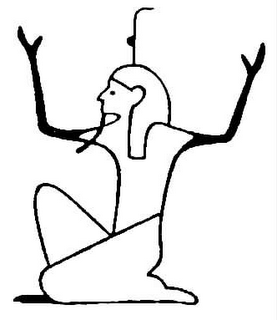
The precise wording of this prayer,
if it was a set prayer, is lost to us today. The Talmud supplies us with an example, but Edersheim and I agree that it rings of a later time period.
The manner of prayer used among Jews was to have uplifted hands, and eyes cast towards heaven. Rather the opposite of the folded arms and bowed head that most of Christian upbringing are made familiar with.
It has been a posture of "crying out" since primitive times, as evidenced by phoenician, egyptian, and proto-Semitic alphabets.
777life.com says: "The earliest visual theme of Hey is a kneeling man (Hue) with raised hands."
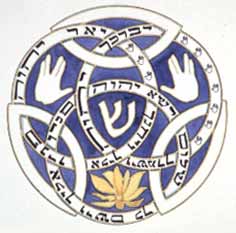
On Yom Kippur, the High Priest was permitted to speak the sacred name of God aloud during his ministry. This was the only occasion on which this was permitted. The Kohen (priests) today give the priestly blessing in Synagogue, with uplifted hands of a slightly different manner, with the fingers oddly divided with two together one way, and two together the other way, and the thumb separate, (as pictured in this beautifully crafted amulet). They say a prayer that, if not substituted, would include speaking the name of God three times. This prayer was instituted by Moses among Aaron and his sons:
And the LORD spake unto Moses, saying, Speak unto Aaron and unto his sons, saying, On this wise ye shall bless the children of Israel, saying unto them,
YHWH bless thee and keep thee;
YHWH make his face shine upon thee and be gracious unto thee;
YHWH lift up his countenance upon thee, and give thee peace.
And they shall put my name upon the children of Israel; and I will bless them. (Numbers 6:22-27)
Getting back to the subject of Temple ministry: As we mentioned above, the High Priest would leave that golden censer burning in the Holy of Holies, to fill the room with smoke so that he could bear the presence of the L
ORD without dying. Upon re-entering the room, presumably the L
ORD would have come in his presence between the wings of the Cherubim upon the Mercy Seat of the Ark of the Covenant, to communicate with the High Priest. The High Priest would have been obliged to cover his nostrils to guard himself from the thick smoke which pervaded the room.
Many Jews have objected to the idea that Master Masons would have held their meetings in the Sanctum Sanctorum or Holy of Holies, even while the Temple was being built. I was told that the Kohen would have built it themselves, and done so from the outside of the room. I would entertain the idea that perhaps our original Ancient Grand Masters, while probably not the three depicted in our Masonic rituals, may have actually been High Priests, after (or before) the same custom as the Tabernacle, thus making them eligible to meet in that room.
I don't know if Masonry holds any sustainable resemblance to the Priesthood which the Israelites held. And if it did, I'm not quite sure what that would imply. Some people think it descends from the Knights Templar. I think that much of it is far older than Templarism.
Further Studies:
Egyptian Henu (Conclusion of Praise Ritual)Egyptian Ka SignThe Temple: Its Ministry and Services
 On John Ratcliff's blog, one of the commentors on a recent post of his made a speculative statement about Brigham Young (the second president of the Mormon church) which I found to be a rather unstudied and inaccurate statement.
On John Ratcliff's blog, one of the commentors on a recent post of his made a speculative statement about Brigham Young (the second president of the Mormon church) which I found to be a rather unstudied and inaccurate statement.

 In the Mark Master Degree (the fourth step in Masonry, and the first of the degrees offered by the Royal Arch Chapter in York Rite) the allegory teaches about a Keystone which was found, whose purpose and design, while recognized as beautiful, were unknown to the overseers of the work, and caused it to be consequently thrown among the rubbish of the Temple.
In the Mark Master Degree (the fourth step in Masonry, and the first of the degrees offered by the Royal Arch Chapter in York Rite) the allegory teaches about a Keystone which was found, whose purpose and design, while recognized as beautiful, were unknown to the overseers of the work, and caused it to be consequently thrown among the rubbish of the Temple.






